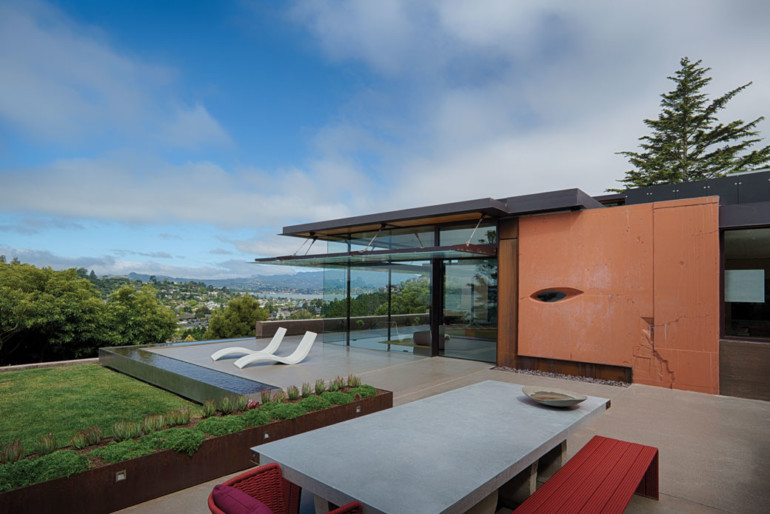FU-TUNG CHENG ISN’T in a hurry. The mainstay contributor to the East Bay design world, whose storefront office on San Pablo Avenue has been a hub of studies in concrete and a variety of design modes, is happy to talk about the musician David Byrne, the CIA’s penchant for recruiting at UC Berkeley when he was graduating in 1971, and his recent discovery of the work of Japanese artist Yayoi Kusama. It’s a languid approach to an interview that, 20 minutes in, has yet to address his most recent project, a house in Tiburon that trips down a hillside and works as a study in reflective planes and multiple forms of concrete, and it gets at least one writer fascinated about what, exactly, this designer is expressing with his work.
This wasn’t the first encounter for designer and client. Cheng worked with the client, a builder/developer, 15 years ago, in another lifetime for both of them. That time, personal and professional issues affected the relationship, leading to a long hiatus during which Cheng continued to explore his architectural relationship to concrete, and the client went about his life. Cheng didn’t think he was likely to find himself in the same river twice.
That was until three or four years ago, when the phone rang. The client had mellowed and was interested in having Cheng work on some interiors for his own home. Why only interiors? “I don’t trust your architecture,” the client said. (He might not have mellowed that much.) So Cheng made him an offer: he would work on retainer, design a house, and if the client didn’t like it, fine — they’d walk away peacefully.
Cheng wasn’t surprised when the client loved the first design he offered — the one they ended up going with. “There was a rationale behind the layering that he liked,” Cheng says, referring to the multiple types and colors and forms of concrete that he introduced for the house. Cheng isn’t a trained architect but a craftsman, someone who came up through the world of carpentry. A keen attention to the texture of details and walls, combined with an iconoclastic approach to spatial layout and siting, accounts for his somewhat outsider status.
That doesn’t mean Cheng doesn’t know about architecture, though. He references Frank Lloyd Wright in discussing the compression and expansion and sense of rhythm that his firm introduced into the house through the judicious use of hallways and parallel concrete walls, as well as the Italian architect Carlo Scarpa, whose influence he sees in the front entrance and the way that orange and red and gray concrete seem to converse with each other. The Scarpa reference particularly comes through in the sequence of entry forms — tapered treads in the staircase, a warm adobe-colored wall — and the relationship between ground, pond and house. “You’re progressing upwards and there are these textures, and part of a rock or a tree,” Cheng says. “It was like a rock canyon.”
The interior is a study in what concrete can be, and the material shows up everywhere. A long entrance hallway is pockmarked with apertures that are backed with a polyurethane cast, a glowing material that would fit right into a Jurassic Park set.
“It looks like a solid piece of amber that has a bug preserved in it for a billion years,” Cheng says. “But it’s not; it’s lodged into a negative space there.” The effect is that of a niche of concrete art in relief. Those translucent apertures contrast with completely transparent ones, like the eye-shaped cut made into the concrete wall that encloses the kitchen — “so he can keep an eye on the kids,” Cheng says, not entirely joking. Playfulness abounds: in the main bathroom, the sink isn’t just a sink; it’s “a lightweight fiber-reinforced [piece of] concrete that is sculpted and molded” and produced in Cheng’s shop.
Why this love for concrete? “In the 19th century, concrete was considered this miracle liquid stone,” Cheng says. His reverence for the different forms the material can take comes through in conversation, and his interest in a material that can change texture, strength and appearance makes sense in context of the rest of his interests.
“I have references to Scarpa, and in my own art background, to organic geological things,” he says. “I’ve merged them to create a tableaux.”
It’s an approach to the world that puts the first wide-ranging 20 minutes of our conversation into context. It’s clear that Cheng’s eyes are open, and he’s excited to show the world what he sees.
This article originally appeared in Marin Magazine's print edition with the headline: "Making Peace".


